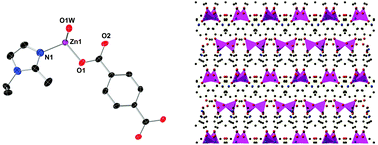Synthesis, structures and photoluminescence properties of mixed ligand divalent metal–organic frameworks†
Abstract
Three new metal–organic frameworks [Co2(bmip)(bdc)2]·2DMF (1), [Cu(bmip)(bdc)]·6H2O (2) and [Zn2(bmip)(bdc)2(H2O)2] (3) have been prepared using a solvothermal process, derived from a flexible N,N′-donor spacer 1,3-bis(2-methylimidazolyl)propane (bmip) and 1,4-benzenedicarboxylic acid (H2bdc) ligands. Whereas compound 1 shows a three-dimensional (3D) framework, exhibiting a pcuα-Po network topology, compound 2 displays a two-dimensional (2D) network structure lying parallel to the plane (1 1 −1) and shows a dia topology. The 2D layers in 2 are further linked by hydrogen bonding that involves water solvate molecules, which in turn results in an infinite 3D hydrogen bonded framework. Compound 3 on the other hand shows a three-dimensional (3D) complicated framework with zigzag chains having a ThSi2 topology. The structural features of 1–3 display diverse variations from 3D, 2D and 3D frameworks, respectively, that are entirely different for each transition metal [Co(II), Cu(II), and Zn(II)] with the same combination of mixed ligands under similar reaction conditions. The physical and chemical properties of 1–3 were investigated by single crystal X-ray diffraction, elemental analysis, FTIR spectroscopy (FTIR), thermogravimetric analysis (TGA) and photoluminescence properties.



 Please wait while we load your content...
Please wait while we load your content...